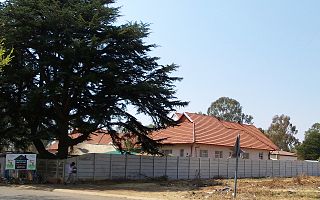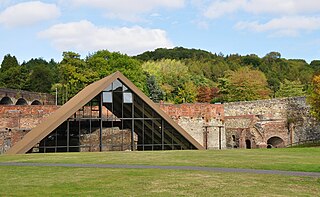
Hhohho is a region of Eswatini, located in the north western part of Eswatini from the north and running southwards to the centre, Hhohho was named after the capital of King Mswati II, who expanded the Swazi territory to the north and west, taking in the districts of Barberton, Nelspruit, Carolina and Piet Retief. These areas were later acquired by what was the Province of Transvaal and today they form part of the Mpumalanga Province of South Africa. It has an area of 3,625.17 km², a population of 320,651 (2017), and is divided into 14 tinkhundla. The administrative center is the national capital of Mbabane. It borders Lubombo Region on the southeast and Manzini Region in the southwest.

Selebi-Phikwe is a mining town located in the Central District of Botswana. It had a population of 49,724 in 2011 which is now estimated to have risen to c.52,000. The town is an administrative district, separate from the surrounding Central District.
A mining accident is an accident that occurs during the process of mining minerals. Thousands of miners die from mining accidents each year, especially from underground coal mining, although hard rock mining is not immune from accidents. Coal mining is considered much more hazardous than hard rock mining due to flat-lying rock strata, generally incompetent rock, the presence of methane gas, and coal dust. Most of the deaths these days occur in developing countries, and rural parts of developed countries.

Gold mining is the resource extraction of gold by mining.

Brakpan is a gold and uranium mining town in the Gauteng province of South Africa. The name Brakpan was first used by the British in the 1880s because of a non-perennial lake that would annually dry to become a "brackish pan".

Carletonville is a town in the West Rand District Municipality in Gauteng, South Africa, just north of the richest gold-mining area in the world. At 3,749 m, Western Deep Levels holds the record for the world's deepest gold mine.

Kinross is a small gold mining town in Mpumalanga, South Africa with four gold mines in the region. Village on the watershed between the Atlantic and Indian Oceans, between Devon and Trichardt, 42 km west of Bethal, 19 km east of Leslie and about 70 km north-north-east of Standerton.
The following lists events that happened during 1960 in South Africa.

Kabwe is the capital of the Zambian Central Province with a population estimated at 202,914 at the 2010 census. Named Broken Hill until 1966, it was founded when lead and zinc deposits were discovered in 1902. Kabwe also has a claim to being the birthplace of Zambian politics as it was an important political centre during the colonial period. It is an important transportation and mining centre.

West Nicholson or Tshabezi is a village in the province of Matabeleland South, Zimbabwe. It is located about halfway between Zimbabwe's second largest city, Bulawayo, and the border town to South Africa, Beitbridge, along the main road and rail link to South Africa.

Mining in South Africa was once the main driving force behind the history and development of Africa's most advanced and richest economy. Large-scale and profitable mining started with the discovery of a diamond on the banks of the Orange River in 1867 by Erasmus Jacobs and the subsequent discovery and exploitation of the Kimberley pipes a few years later. Gold rushes to Pilgrim's Rest and Barberton were precursors to the biggest discovery of all, the Main Reef/Main Reef Leader on Gerhardus Oosthuizen's farm Langlaagte, Portion C, in 1886, the Witwatersrand Gold Rush and the subsequent rapid development of the gold field there, the biggest of them all.

Gold mining in the People's Republic of China has made that country the world's largest gold producer by far with 463.7 tonnes in 2016. For the year 2007, gold output rose 12% from 2006 to 276 tonnes to become the world's largest for the first time—overtaking South Africa, which produced 272 tonnes. South Africa had until then been the largest for 101 years straight since 1905. The major reasons for this change in position had been due to South African production falling by 50% in the past decade as production costs there have risen, more stringent safety regulations have been implemented, and existing mines have become depleted.

Albas is a commune in the Aude department in the Occitanie region of southern France.

La Machine is a commune in the Nièvre department in central France.
Mining is the biggest contributor to Namibia's economy in terms of revenue. It accounts for 25% of the country's income. Its contribution to the gross domestic product is also very important and makes it one of the largest economic sectors of the country. The majority of revenue comes from diamond mining.
Youga is a village in the Zabré Department of Boulgou Province in south-eastern Burkina Faso, about 2 km north from border with Ghana. As of 2005, the village had a population of 1018, but due to discovery of gold in the vicinity and subsequent establishment of Youga Gold Mine, population is growing.

Blyvooruitzicht is a gold mine and gold-mining village in Gauteng, South Africa. It is situated about 5 km south of the centre of Carletonville and 80 km westwards from Johannesburg.
Acacia Mining is a gold mining business operating in Tanzania, with exploration properties in Kenya, Burkina Faso and Mali. It is listed on the London Stock Exchange and the Dar es Salaam Stock Exchange and is a constituent of the FTSE 250 Index. Acacia's majority shareholder is Barrick Gold, which owns 63.9% of the company.

Bulyanhulu Gold Mine is an underground gold mine in the Shinyanga Region of Tanzania, located 55 kilometres south of Lake Victoria. It is one of three gold mines owned by Acacia Mining plc, formerly African Barrick Gold plc, a company owned by Barrick Gold, which is listed on the London Stock Exchange, and operates in Tanzania. Acacia also owns Buzwagi Gold Mine and the North Mara Gold Mine.



















